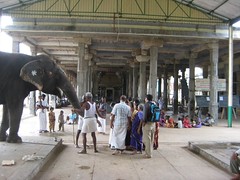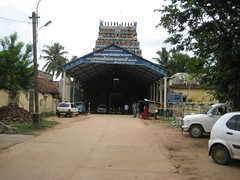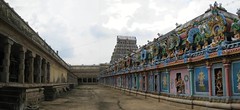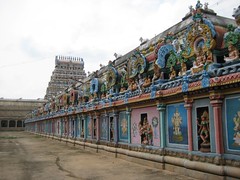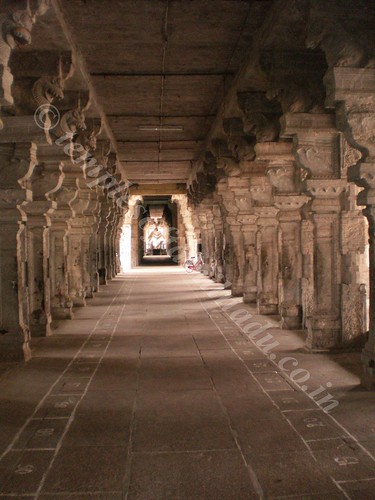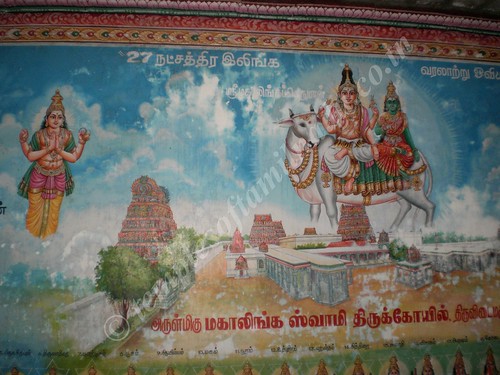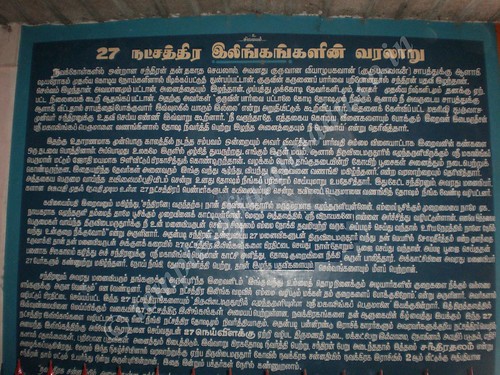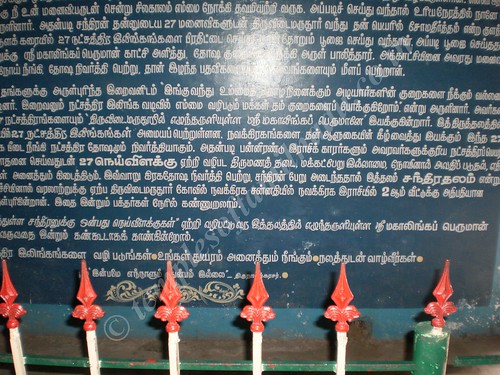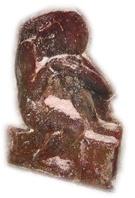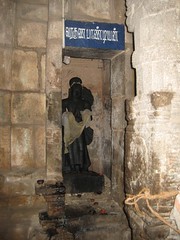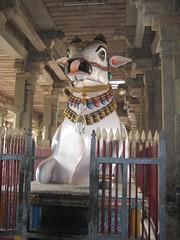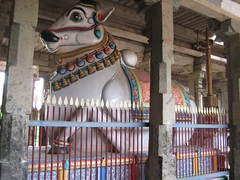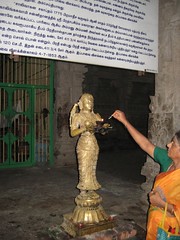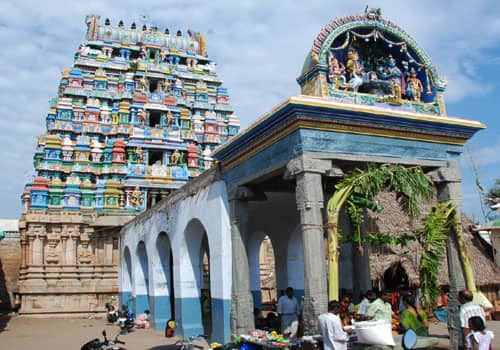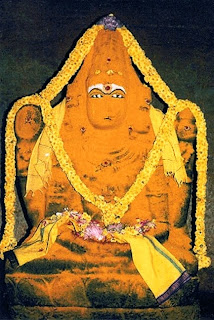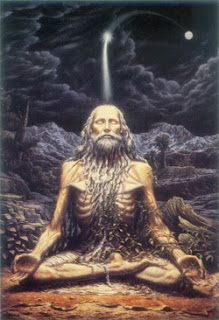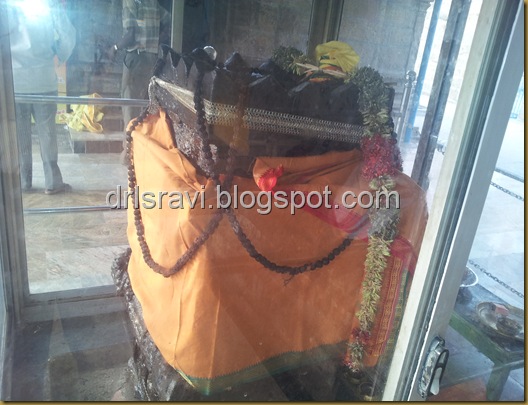as the story goes he was trembling in fear as he had brahmahathi dosha . it got relived only in this temple as he enters the temple the brahmahathi could not follow him at one stage as it waited near the the entrance itself to catch hold of the king as he come out. but he king entered trembling and fell in the feet of mahalinga and tears were rolling. by then a divine voice heard and told him not to get afraid of that brahmahathi and asked him to go by the another gopuram so that brahmahathi wont follow. as said by god he rode horse very fast through another gopuram and he didnt even turn back to see and he turned back to see whether brahmahathi is not following only when he came some kms away and that place is now callled as thirubuvanam. thirubi parththal thirubuvanam. its meaning in tamil is as he turned in that place its called so so lets see that temples history now come with me.
SIDE PRAHARAM
AS WE ENTER FROM ROAD
Mahalingeswarar Temple is a Hindu temple dedicated to Shiva located in the town of Thiruvidaimarudur in Tamil Nadu, India. Shiva is worshipped in the form of a lingam in this temple. The temple is considered to be one of the six most sacred places dedicated to Shiva.
How To Reach:
Thiruvidaimarudur is located around 8 k.m north of Kumbakonam city on the road to Mayiladuthurai. All the buses pass via this route with a stop closer to the temple at Thiruvidaimarudur. The distance from Mayiladuthurai (Mayuram) is around 32 km. Autos / Taxies from Kumbakonam are available.
There is a small Railway station at Thiruvidaimarudur. Only the passenger trains stop there. The nearest convenient railway station is located at Kumbakonam with connectivity to Chennai (via Trichy), Thirunelveli (via Dindugal, Madurai), Coimbatore (Satapthi), Mysore(Via Erode – Salem – Bangalore).
The Ambal Shrine is one of the Sakthi Peetams and is on the right side of the Swami shrine, that is on southern side as a KALYANA KOLAM – a rare one. Chakara Maha Meru is installed here.
Ambal
The consort of Shiva is worshipped as Perumulai Naayaki or Brihad Sundara Kuchambal. The Ammbal Shrine is one of the Sakthi Bheetas. Chakkara Maha Meru is installed here. Within the Ambal shrine complex, there is a separate shrine for Mookambika in the posture of doing penance built in the North Indian style. She is mentioned as Pidari Parameeswari in inscripitions. The main Mookambika temple is in Karnataka on the banks of the river Chowparnika and the other is, this one on the banks of the river Cauvery. Though the structure has been built in later days the goddess must have been there in olden times.
presiding dieties
(i) Aswamedha pradhakshina praharam – Going around this will give the effect of doing Ashwamedha yaga. This should be at least half a KM and is quite divine and popular here like Thiruvannamalai girivalam. Those in ill health believed to have been caused by evil spirits, are said to find relief through prayers offered in this shrine and through circumambulation of this outermost prakaram
(iii) Pranava praharam – Going around this will give Moksha.
temple corridor with beautiful pillars in opposite side of nandi
The legend of a Chola prince who killed a Brahmin and was in turn, pursued by his spirit (brahmahatthi), is associated with the temple. The Chola prince, it is believed, entered the Mahalingeswarar Temple and prayed to his favourite God, Shiva for relief from the clutches of the spirit of the dead Brahmin or brahmahatthi. The Chola prince made his way out through another entrance thereby saving himself.[7] It continues till day where people take the second entrance to exit the premises after worship. There is a sculpture of Chola brahmahatthi on the eastern premises in one of the inner gopurams (tower gate
Mahalingeswarar here is the main deity
of the Parivara sthalams. Parivara Sthalams are a group of temples
which together form a much larger temple. The Presiding deity of such a
huge temple is Mahalingeswarar at Thiruvidamarudhur. The Group of
temples which form this large temple is as follows:
- Mahalingeswarar at Thiruvidaimarudhur
- Vinayakar at Thiruvalanchuzhi
- Murugan at Swamimalai
- Ambal at Thirukkadaiyur
- Dakshinamurthy at Alangudi
- Navagraha Sannidhi at Suryanar Koil
- Saneeswaran at Thirunallar
- Durgai at Patteeswaram
- Chandikeswarar at Sengalur
- Bhairavar at Sirkali
- Natarajar at Chidambaram
- Somaskandar at Tiruvarur
- Nandikeswarar at Tiruvavaduturai
There
are four other main Lingams viz Viswanathar, Rishipureeswarar,
Aatmanathar and Chokkanathar around the Presiding Deity. Since there
are five Lingams, this place is a Panchalinga sthalam. Apart from these
five Lingams there are also Lingams dedicated to each of the 27
nakshatrams (Birth Stars). All these 27 birth stars installed a Lingam
each and worshipped Lord Shiva here. This is the temple for performing
parihara pooja (remedial pooja) for the malefic effects of the Birth
stars.
VARAGUNA PANDIAN
This temple is closely connected to the life of a Pandya King by name
Varaguna Pandyan. Once when Varaguna Pandyan was returning from a
hunting expedition, his horse accidentally trampled upon and killed a
Brahmin. Since he was the cause of the death of a Brahmin he was
afflicted with Brahmahatti Dosham (Sin due to murder of Brahmin). As a
result, he was constantly haunted by the Brahmin’s ghost. The King
prayed to Somasundarar at Madurai seeking relief from this sin. Lord
Somasundarar appeared in the King’s dream and directed him to pray Him
at Thiruvidaimarudhur for relief. Thiruvidaimarudhur was under Chola
rule and they were bitter enemies of the Pandyas. There was a war
between the two in which the Cholas were defeated. The King then
visited the temple at Thiruvidaimarudhur as per the Divine guidance and
prayed to Lord Mahalingeswarar. He entered the temple through the
Eastern entrance and the Brahmahatti and the ghost could not enter the
temple and waited outside the temple for the King to return. As advised
by Mahalingaswamy, the King left by the Western Gopuram (Tower) and
hence got rid of the Brahmatti dosham and the Brahmin’s ghost. Even
today, devotees use different gopurams to enter and exit the temple
premises.
Birth of Nandi (According to Linga Puranam)
It was Nandi who cursed Ravana (the demon King of Lanka) that his kingdom would be burnt by a monkey (Vanara). And later Hanuman burnt Lanka when he went in search of Sita, who was kept prisoner by Ravana in Ashok Vatika. In one puranic story, it is stated that once Siva and Parvathi were playing a game of dice. For any game there has to be an umpire, who has to declare who is the winner. Siva and Parvathi agreed to have Nandi (the divine bull) as the umpire. Nandi is a favorite of Siva, as he is Siva's vehicle. Although Siva lost the game, Nandi declared him the winner. It is stated that Parvathi was indignant over Nandi's partiality for Siva and cursed him that he should die from an incurable disease. Thereupon Nandi fell at the feet of Parvathi and pleaded for forgiveness. "Mother forgive me. Should I not show at least this amount of gratitude to one who is my master? Is it not humiliating for me to declare that my master has lost the game? To uphold his honor I no doubt uttered a lie. But am I to be punished with such severity for so small an offence?" Nandi prayed for forgiveness in this manner. Parvathi forgave Nandi and taught him the means to atone for his lapse. She told him. "The Chaturdasi day in the month of Bhadrapada is the day when my son's birthday is celebrated. On that day you have to offer to my son what pleases you most (green grass)". This means that one atones for one's sins when one offers to the Lord what is most pleasing and enjoyable to him. For Nandi the most enjoyable and relishing food is green grass. As directed by Parvathi Nandi worshipped Ganapathi by offering green grass. Nandi was then relieved of his dreaded disease. His health improved and by the grace of Parvathi he was redeemed.
- Lepakshi, Andhra Pradesh
- Brahadishwara Temple, Tamil Nadu
- Chamundi Hills, Mysore, Karnataka
- Bull Temple, Bangalore, Karnataka
- Rameswaram, Tamil Nadu
- Hoysaleswara Temple, Halebidu, Karnataka
- Shanthaleswara Temple, Halebidu, Karnataka
- Vadakkunnathan Temple, Thrissur, Kerala
- Virupaksha Temple, Hampi, Karnataka
- Nandi Temple, Western Group of Temples, Khajuraho, Madhya Pradesh
- Kedareshvara Temple at Balligavi (Karnataka)
very big white nandi as it is told that its growing even today
pavai vilakku donated by ammuni ammal
Pavai Vilakku
Ammuni Ammal, lover of Maratya king Pratap singh lit laksha deepam
(1,00,000 lamps) and donated a Pavai Vilakku, a lamp in the shape of
herself. The lamp measures 120 cm (height), 411 ¾ cher (Weight) in
brass, designed and made by Kannara Aryaputra Patther. Her story is
inscribed at the base of the lamp.
It is one of the biggest Thers (Temple Car) of Tamilnadu. It measures 89 feet from top (tip of the Kalasams) to bottom (ground level).The octagonal lower part of the, measuring 14½ feet (length) and 14½ feet was carved beautifully. The axles (cuboids) on the outer surface of the wheels measure 29 feet (length), 1¾ feet (width) and 1¾ feet (height). The rampant wooden horses which fastened in front of the Ther measure 25½ (length) and 8 feet (circumference of the body). The Kodimaram (flag post) on the Ther measures 24 feet (height). The inner large rope (Ul vadam) tied around the Ther measures 800 feet. The outer cable (large rope- Vadam) used to pull the Ther by 5000 people (man power) measures 1000 feet. The pedestal on the Ther measures 14½ x 14½. The wooden sculptures such as Panchamurtis, Kayilayakkatchi, Narasimhamurti, Bairava, Chandra, the worship of Mahalingeswara (seated beneath the Maruda tree) by Vinayaka and Ambikai, His Holiness Gurumaha sannidhanam and other sculptures are worth mentioning here. The Ther was donated to the temple by Amarsingh’s son Pratap singh(Simha) in 1800 AD. He had presented a silver Ratha (chariot) also. There is a small wooden Ther for procession during the Tamil month Adi.
Appar has glorified the temple in five, Cuntarar in one and Campantar in six verses.[9] Appar refers the temple as Idaimaruthur.
-
-
-
- "பாச மொன்றில ராய்ப்பல பக்தர்கள்
- வாச நாண்மலர் கொண்டடி வைகலும்
- ஈச நென்பெறு மான்இடை மருதினிற்
- பூச நாம்புகு தும்புன லாடவே"[18]
-
-
-
-
-
- மங்கை காணக் கொடார்மண மாலையைக்
- கங்கை காணக் கொடார்முடிக் கண்ணியை
- நங்கை மீர் இடைக் மருதரிந் நங்கைக்கே
- எங்கு வாங்கிக் கொடுத்தார் இதழியே[18]
-
-
translating to
-
-
-
- "Praise to you father in Idaimaruthur.
- Praise to you who carried Ganges river in your plait."[19]
-
-
-
-
-
- "Because of our loneliness it is difficult for us to keep company of with dark ghosts
- So my tongue will go on uttering the saiva agamas in the presence of the companion (mind)
- to the accompaniment of the unrivalled music of Tiruvidaimaruthur"[20]
-
-
-
-
-
- "You are the Esan who had blessed Brahman, Vishnu and Indra when they bowed.
- You descended on earth and disclosed your perfect ways.
- You, in your grace, gave supreme virtues to that good dame of Idaimaruthur that is full of mansions set with good and brightful gems
- Our Lords are those who know that grace
-
-
There are as many as 35 Theerthams associated with this temple.
- There are 3 places where a sacred well is in the form of a lion (Singa kinaru). Gangaikonda Cholapuram, Vrinchipuram and this place. It is called KrishnaKupam
- Karunyamitra theertham on the east side of the temple, where Chittirai vizha Festival is important is the best known theertham.
contact details
Sri Mahalinga Swamy Temple
Thirumanjana Street
Thiruvidaimarudur - 612 104.
Telephone 0435-2460660.
Thirumanjana Street
Thiruvidaimarudur - 612 104.
Telephone 0435-2460660.




